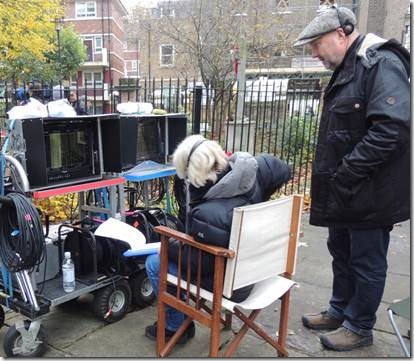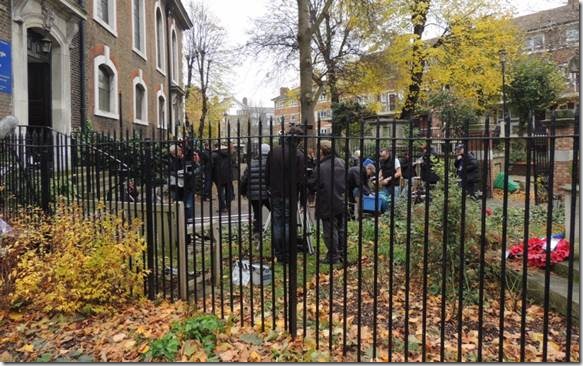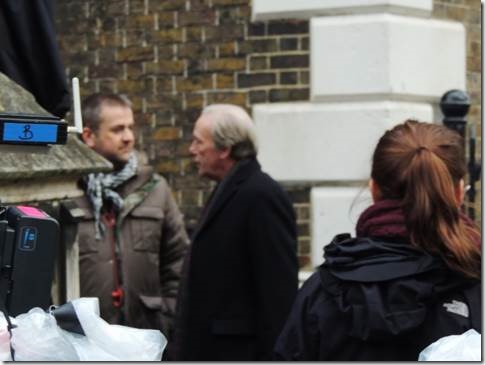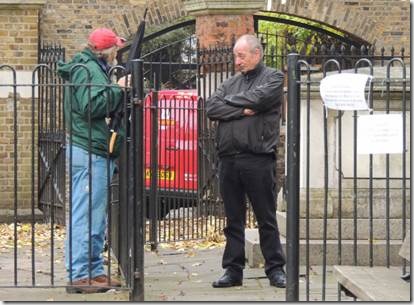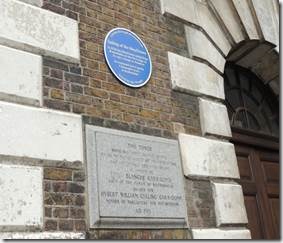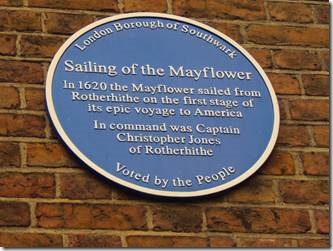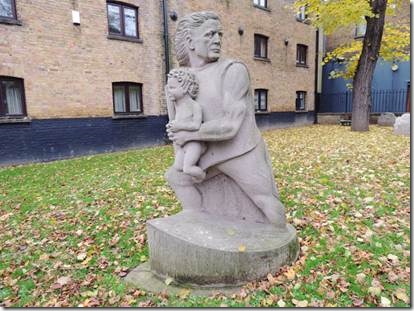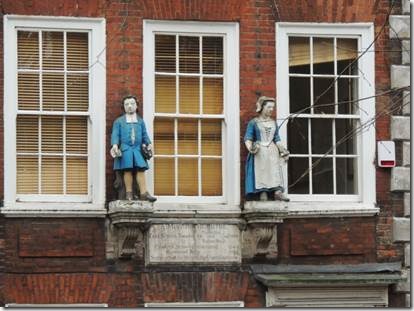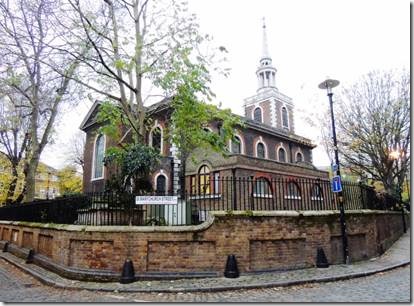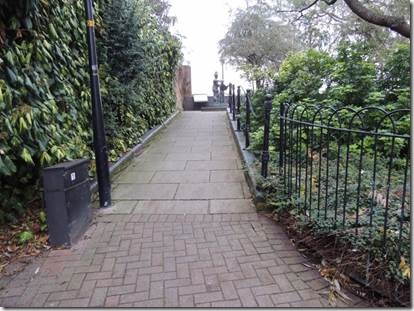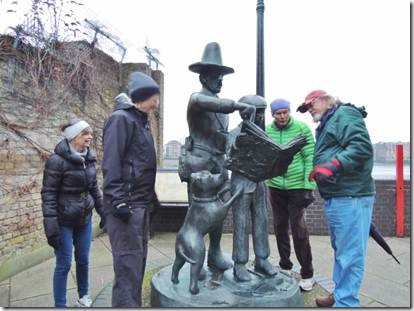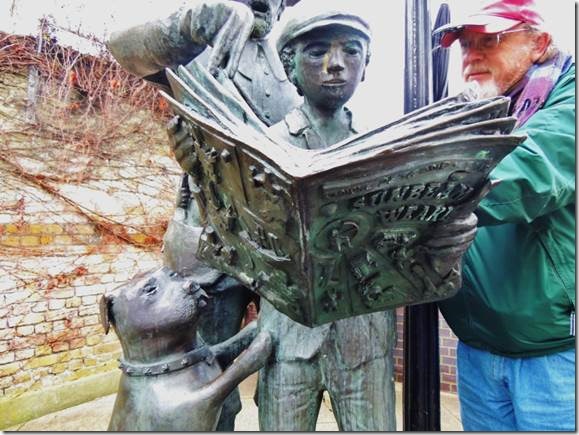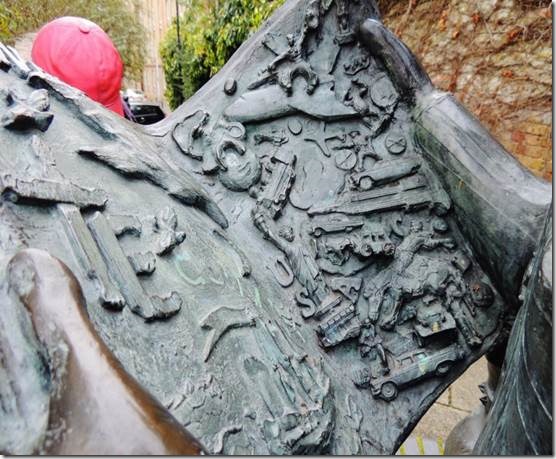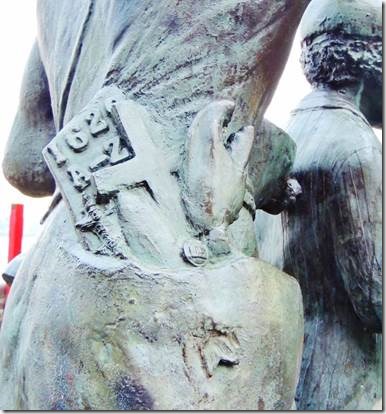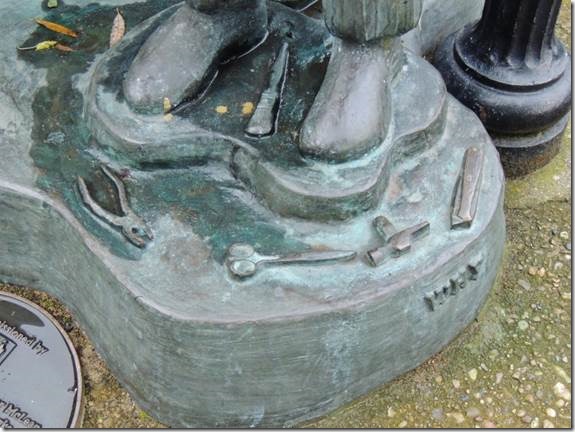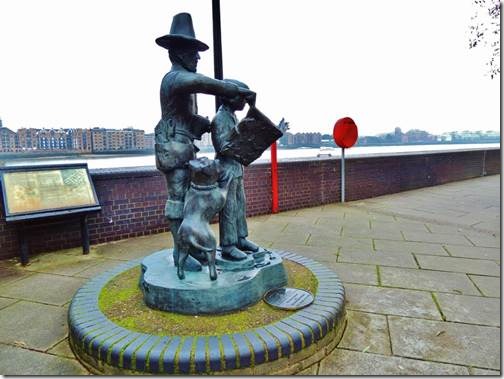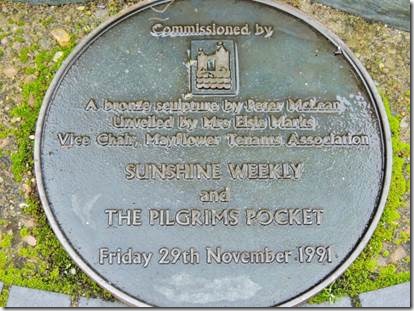Cheers,
It was a very overcast day weather-wise, but Randal and I had a lovely Thanksgiving Day here in London, or Rotherhithe to be exact. I think it’s the first time that I’ve actually thought about Pilgrims rather than food and football, which is slightly embarrassing, as I grew up in Massachusetts on Plymouth Street. Our 6th grade school trip was to Plimoth Plantation but who cared then. Now it’s pretty interesting. I hope you all enjoyed your day and I do hope if your team was playing, it won.
Randal and I did manage to visit all of the places I’d mapped out on our way to Thanksgiving Lunch at the Mayflower Pub:
-St. Mary Church-Rotherhithe to see the burial place of Mayflower Captain Christopher Jones.
-The Pilgrim and Lad statue
-The Brunel Museum.
But what we found at those places wasn’t always what we’d expected. It was better!
BBC Police Drama “New Tricks” at St Mary’s
“Drama featuring an eccentric group of ex-police officers brought out of retirement to investigate unsolved crime.” http://www.bbc.co.uk/programmes/b006t0qx I watched an older episode online and I recognized Inspector Dalgliesh from the PD Janes series in a guest role and the wonderful older solicitor from the Garrow’s Law series as one of the main characters.
|
With all the activity at the Church, I thought there was a “yard sale” happening. But when I got closer I saw there were no tables of “for sale” items. It was only a bit later that we found out it was the BBC taping a show. |
|
Shooting Take 1, I think I heard. It involved a car needing to drive by several times for the scene… or waiting for a car to pass that wasn’t in the scene. I’m not sure which. And no one seemed to be wanting to chat it up with me about what was happening. |
|
Actor Dennis Waterman center, one of the show ‘s stars. |
|
Two former marines having a chat. I asked this gentleman if he knew where Christopher Jones was buried. But he was part of the BBC crew so couldn’t help with that but did tell us all about the show which was fun. He and Randal had a lovely chat while I watched some of the filming. It sort of distracted me from looking inside the church…so that will be another visit. |
|
I did find this commemorative plaque but not the one specific to Christopher Jones. The tablet below was a thank you to the family who rebuilt the crumbling tower. “Captain Christopher Jones was not a local man, although he was resident in Rotherhithe at the time of Mayflower’s departure for Southampton. He was born in Harwich at around 1570 and only moved to Rotherhithe in 1611. It was a popular place for sea captains to live in the 17th Century, and it is probable that Jones knew ship owner Edward Maister. Captain Jones died on the 5th March in 1622, in his early 50s, and was buried in the churchyard of St Mary’s in Rotherhithe. The church of St Mary’s was rebuilt in 1715, by public subscription, due to damage inflicted by repeated flooding. Many of the old churchyard monuments and memorials were lost during this process, and the exact location of the burial of Christopher Jones is no longer known. Apparently there is a stone tablet in memory of him saved from the old church and set into the new tower’s wall. (We only found the plaque.) There is modern monument to him in the churchyard of St Mary’s, depicting St Christopher, the patron saint of travellers, holding a small child. It was unveiled in 1995, to mark the 375th anniversary of the voyage. http://russiadock.blogspot.co.uk/search/label/Public%20art This is a great website for Rotherhithe history. The St. Christopher Statue in honor of Christopher Jones |
|
“Rotherhithe’s most ancient “blue coat school” “Rotherhithe has throughout its history been a strongly maritime area, home to docks, ship builders and breakers. This building (across the lane from St Mary Church) was the home to Rotherhithe’s most ancient school, which was founded in 1613 by Peter Hills and Robert Bell. Peter Hills was an eminent mariner and the school was for "eight sons of mariners from the parish". The school grew, accepting both girls and boys. At one point in the early 18th century it had 65 girls and 77 boys. In 1836 a girls’ school opened nearby and the school no longer took girls. By the end of the 19th century about 150 boys were educated at the school. The original building was on the north side of St Marychurch Street. The school moved to this building in 1795. The school provided an education for Rotherhithe children until 1939. The figures are of Portland stone and the children are wearing the traditional blue coats of charity schoolchildren, which gave the name "Bluecoats" to such schools. Beneath the statues is an inscription: St MARY ROTHERHITHE Free School founded by Peter Hill and Robert Bell Esqrs 1613 Charity school instituted 1742 Removed here 1797 Supported by voluntary contributions Sources of Information: • The Story of Rotherhithe by Stephen Humphrey. London Borough of Southwark. ISBN 0 905849 21 3 • Secret London Bluecoats. Pictures of these and other bluecoats statues in London. • www.stmaryrotherhithe.org St Mary’s Rotherhithe Parish Website. More information on Peter Hills and the school. |
|
St. Mary the Virgin-Rotherhithe http://www.stmaryrotherhithe.org/ “……At this time the heart of the village of Rotherhithe was the parish church of St Mary the Virgin. There had possibly been a church on this site since Saxon times; the building standing in 1620 dated from at least the early 12th Century. The list of rectors goes back to 1282. The Church’s position on the river bank, made its tower a welcome landmark to homecoming sailors. The lovely building which stands on the same site today dates mainly from 1714, but a number of memorials preserved from the earlier church provide evidence that this was a parish of seafarers. A finely sculptured stone relief of a ship in full sail, nearly contemporary with the Mayflower, commemorates Captain Anthony Wood who died in 1625. The epitaph of Captain Roger Tweedy who died in 1655, leaving ‘Two Shillings every Lord’s day forever to be distributed among twelve poor seamen or seamen’s widows in bread’, is obviously that of a Rotherhithe Sailor: ‘His soul a ship with graces fully laded Through surges deep did plough and safely waded. At Rotherhithe he did at length arrive And to their poor his tribute fully gives And in this port he doth at anchor stay, Hopefully expecting Resurrection’s day’. Rotherhithe men who were not sailors were shipbuilders and their wooden sailing ships looked a fine sight at anchor in the Thames. In 1612 Rotherhithe received recognition as an official centre of the shipwright’s craft when a charter was granted to ‘The Master, Wardens and Commonality of the Art or Mystery of Shipwrights of Redrith in the County of Surrey’. Even in the 17th Century there was a dry dock at Rotherhithe. In 1700, the first of the great wet docks was constructed, known originally as the Howland Great Wet Dock after the Howland family who were the landowners at that time. Its purpose was to provide safe harbourage for ships, which had earlier been forced to anchor in mid river and suffer buffeting by storms. It came to be known by its present name, the Greenland dock, after 1725 when the South Sea Company leased it for the Greenland whaling trade. The other docks, which made up the 365 acres of the Surrey Commercial Docks, were constructed in the 19th Century. |
|
We continued down Rotherhithe Street to its intersection with Swan Lane to find “the most amazing statue of a time travelling pilgrim.” You can just see the tall pilgrim hat at the end of the path….he looks like the Tin Man from a distance. http://www.youtube.com/watch?v=ylBltWIX3Vg is a very “home done” video but fun to watch. |
|
Sunbeam Weakly and the Pilgrim’s Pocket by Peter McLean. (The sculpture reads "Sunbeam Weakly" but the marker says "Sunshine Weekly." ) Judy, Helen, Warren and Randal This photo was taken after lunch; some of our friends wanted to see the statue. “The statue, “Sunbeam Weekly and the Pilgrim’s Pocket” stands on the walkway at Cumberland Wharf. The work is by Peter McClean, depicting a newsboy in 1930’s attire, reading a copy of the newspaper depicting the story of “The Mayflower” and all that has happened in the USA since those early days. The pilgrim is reading the paper over the boy’s shoulder, looking astonished at how the world has developed since he landed at Plymouth Rock in 1620. The boy’s dog also appears to be trying to read the newspaper, standing on its hind legs.” http://www.thamespathway.com/chapter13/rotherhithe.aspx |
|
The young boy is reading a graphic novel! Sunbeam Weakly “Created by local artist Peter McLean it was erected in 1991 and shows the ghost or spirit of a representative Pilgrim Father looking over the shoulder of a small boy in 1930s clothing, who is reading a magazine called the Sunbeam Weekly. A dog stands on its hind legs, its front paws resting on the boy’s legs, looking as though it wants to be involved. It is a Staffordshire bull terrier which is particularly appropriate for this area, where every other dog seems to be a staffie. All three stand between a gas lamp.” http://russiadock.blogspot.co.uk/ |
|
Past and future…. The Mayflower on the Left and a good deal of New York City on the Right though maybe Boston would have been a more acurate location to se the future for the Mayflower pilgrims. |
|
1620 London A to Z atlas, fish, cross, US button, Lobstah claw and under the letter A what might be a daggar? |
|
Paintbrush, pliers, scissors, hammer head and knife and the word WHY. |
|
Converted wharehouse buildings line the Thames on both banks “The sculpture is accompanied by an explanatory information board which has, understandably, deteriorated since the LDDC put it up some 20 years ago. It needs replacing, because much of it is illegible, particularly in the section that covers the background details about sculptor Peter McLean. The bits that can be deciphered are basically a CV of McLean’s college past and the galleries in which he exhibited, and doesn’t say anything about other items he produced. However it also describes the brief to which McLean worked, which was to create something that reflected local heritage, to be figurative rather than abstract, and to aim for something light-hearted.” http://russiadock.blogspot.co.uk/2013/08/sunbeam-weekly-and-pilgrims-pocket.html has more detailed photos than I am showing. |
|
Plaque reads… Sunshine Weekly
|
Next email will be our visit to the Brunel Museum and Lunch at the Mayflower Pub

